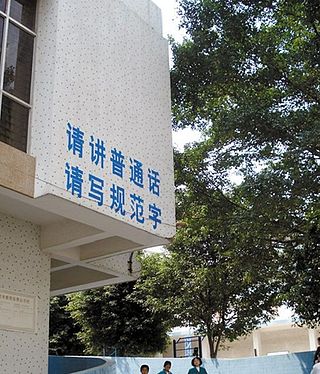Top Qs
Timeline
Chat
Perspective
Protection of the varieties of Chinese
Language preservation efforts From Wikipedia, the free encyclopedia
Remove ads
Protection of the varieties of Chinese (simplified Chinese: 保护方言; traditional Chinese: 保護方言) refers to efforts to protect the continued existence of the varieties of Chinese in mainland China and other Sinophone regions, amid pressure to abandon their use, usually in favor of Standard Chinese.[1][2][3][4]
You can help expand this article with text translated from the corresponding article in Chinese. (July 2019) Click [show] for important translation instructions.
|

Remove ads
Background
Education and media programming in varieties of Chinese other than Mandarin have been discouraged by the governments of China, Singapore, and Taiwan.[5][6] For forty years following the arrival of the Kuomintang (KMT) government in Taiwan, the Taiwanese Hokkien, Hakka and Taiwan aboriginal languages were suppressed by the government in favor of Mandarin Chinese, until the mid-1990s.[7]
China
The Constitution of China calls on the government to promote Standard Chinese as the common tongue of the nation,[8] and as a result, the majority of Chinese citizens speak Standard Chinese.[9] Teaching the varieties of Chinese to non-native speakers is discouraged by Chinese law.[10] The Guangdong National Language Regulations were passed by the Guangdong provincial government in 2012 to promote the use of Standard Chinese in broadcast and print media at the expense of the local standard Cantonese and other related dialects. It has been labelled "promoting Mandarin; abandoning Cantonese" (simplified Chinese: 推普废粤; traditional Chinese: 推普廢粵) legislation.[11]
Remove ads
By country
Summarize
Perspective
China
The Ministry of Education has claimed to be taking active measures to protect ten varieties of Chinese.[1]
Min Nan
In June 2007, China created a zone for the protection of Min Nan culture, the first of its kind in mainland China. In March 2010, eighteen elementary schools and ten kindergartens in Xiamen became Min Nan study centers, complete with Min Nan educational materials, including training in pronunciation, colloquialisms and history. On March 5, 2011, the Xiamen Experimental Elementary School implemented the "Min Nan Day" activity, encouraging students to study Min Nan culture.[12][13]
Taiwan
The native language of many inhabitants of the Matsu Islands of Taiwan is the Matsu dialect, which is one of the statutory languages for public transport announcements in the county.[citation needed] It has been compulsory in primary schools in the area since 2017.
In an amendment to Article 14 of the Enforcement Rules of the Passport Act (護照條例施行細則) passed on August 9, 2019, the Taiwanese Ministry of Foreign Affairs announced that Taiwanese can use the romanized spellings of their names in Hoklo, Hakka and aboriginal languages for their passports. Previously, only Mandarin Chinese names could be romanized.[14] Since 2017, Taiwanese language classes have been compulsory in all primary schools except those in predominantly Hakka or Aboriginal areas and the Matsu islands.
Remove ads
See also
References
Wikiwand - on
Seamless Wikipedia browsing. On steroids.
Remove ads
